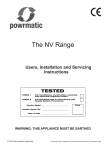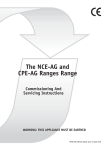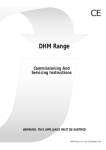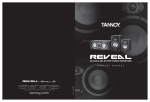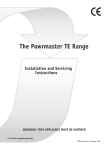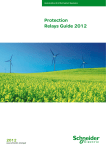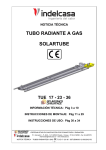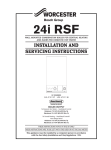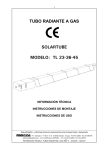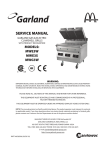Download NV A4 in house.FH11
Transcript
NV Range Issue 4 February 2006 1. INTRODUCTION The NV range are highly efficient gas fired, fanned circulation air heaters that cover heat outputs of 10kW to 140kW, have a closed combustion circuit and are supplied complete with a flue system. They are certified for use on Natural Gas, Group H - G20, and Propane - G31 only. Appliance Categories are Cat II2H3P (GB, IE). The heaters are designed to be suspended from suitable roof points or alternatively to be mounted on purpose designed brackets and are intended primarily for heating commercial or industrial premises. They may be used where the atmosphere inside the premises could be contaminated e.g. Dust, oil mist etc. but the heaters are not airtight and therefore may not be used in areas classified as hazardous as defined in BS 5345: Part 2 or areas subjected to significant negative pressures due to extract systems. NV/F heaters have an axial fan assembly fitted at the rear to circulate the air being heated through the folded tube heat exchanger. NV/D units can be supplied with a centrifugal fan/silencer duct section or as a standalone unit for use with ducted systems where the air moving fan is by others. The NV/DH units are for use in air handling units. Heaters are fitted as standard with atmospheric inshot burners, a fully automatic control for ignition, flame sensing, gas supply control and safety functions, an internal exhaust fan, main air fan (/F and /D (optional) models), fan timer and limit thermostat. Options include High/Low or Modulating burner controls, inlet duct connection, outlet duct connection, 45° head, 90° outlet bend, vertical/horizontal outlet louvre assembly and a full range of modular duct components. Gas Safety (Installation & Use) Regulations It is law that all gas appliances are installed, adjusted and, if necessary, converted by qualified persons* in accordance with the current issue of the above regulations. Failure to install appliances correctly can lead to prosecution. It is in your own interests and that of safety to ensure that the law is complied with. * e.g. Corgi Registered 2. TECHNICAL DATA K Alternative flue positions 10mm Suspension points B 700 J 120 G H F A L Front F 455 Side D C E Top NV20/D WITH CENTRIFUGAL FAN/SILENCER SECTION SHOWN B Alternative flue positions 700 H 120 G F 455 A F D 65 M Front C Side E Top NV60/D SHOWN B 700 J H F Alternative flue positions A Front Side Alternative flue positions 120 G 455 F D C Top C NV140/F SHOWN E G G D D E E Q Q O P N H Rear View NV10-75 J O P N 870 Rear View NV90 - 140 870 J Table 1. Dimensions Model A B NV10 NV15 NV20 D E F G H 750 296 192 J K 109 181 120 262.5 590 NV25 818 NV50 970 NV60 818 NV75 970 NV90 705 NV120 870 2345 870 NV140 1035 N 116 750 944 752 904 1948 804 2014 88 MODEL NV10 NV15 NV20 NV25 NV30 NV35 NV40 NV50 NV60 NV75 NV90 OUTPUT LOW FIRE INPUT (Nett) kW F D F D F D F D F D F D F D F D F D F D F D NV120 F NV140 F D D MAXIMUM AIR DUCT VOLUME OUTPUT RESISTANCE kW m³/s 10.79 10.0 6.57 5.90 0.2601 16.00 15.0 8.22 7.50 0.3902 890 624 153 789 401 954 21.85 20.0 11.58 9.92 0.5203 27.32 25.0 16.50 14.30 0.6503 32.60 30.0 18.34 16.30 0.7804 39.32 35.0 23.1 19.0 1.000 43.48 40.0 24.19 21.22 1.0405 54.23 50.0 28.40 24.83 65.22 60.0 35.63 31.49 FAN MOTOR NOISE LEVEL WEIGHT Pa kW dB(A) @ 3m kg N/A 140 0.040 0.370 N/A 145 N/A 0.120 0.370 0.070 45 N/A 54 53.0 91.5 54.0 106.5 68.0 120.5 89.0 126.5 89.0 166.5 89.0 166.5 93.0 168.5 114.0 183.0 130.0 213.0 150.0 234.0 188.0 343.0 260.0 363.5 260.0 424.0 180 0.370 N/A 0.180 145 0.560 N/A 50 N/A 55 N/A 0.180 N/A 56 250 N/A 1.100 0.300 N/A 60 240 N/A 1.100 0.300 N/A 60 240 1.100 1.3006 N/A 200 0.440 1.100 N/A 61 1.5608 N/A 250 0.550 1.35 N/A 260 0.550 1.35 N/A 2 x 0.440 81.25 75.0 42.61 37.50 1.9510 95.25 90.0 58.50 54.50 2.3412 126.32 120.0 75.45 71.00 3.1215 148.93 140.0 98.92 92.55 3.6418 N/A 63 N/A 65 N/A 67 200 2 x 1.10 N/A 2 x 0.550 N/A 67 280 N/A 2 x 1.35 2 x 0.550 N/A 68 285 2 x 1.35 N/A Note: /D data refers to Powrmatic supplied centrifugal/silencer duct section 100 738 Table 2 - Specifications INPUT (Nett) 80 890 1010 146 969 HIGH FIRE 510 738 151 639 258 202 220 244.5 Ø (mm) 83 123.5 Flue Q 151 227 752 904 248.5 P 189 697 631 1345 740 O 502 524 118 172.5 142 236.5 NV40 M L 436 1000 506 176 NV30 NV35 C 130 Table 3.1 Injector Sizes & Burner Pressures Natural Gas - Group H - G20 Net CV (Hi) = 34.02MJ/m³ Inlet Pressure 20mb MODEL NV10 NV15 NV20 NV25 NV30 NV35 NV40 NV50 NV60 NV75 NV90 NV120 NV140 INJECTORS No. 4 4 4 5 6 6 8 10 8 10 6 8 10 Size mm 1.36 1.67 1.94 1.94 1.94 2.26 1.94 1.94 2.54 2.54 3.5 3.5 3.5 High Fire Burner Gas Rate Pressure Low Fire Burner Gas Rate Pressure Marked mbar m³/h mbar m³/h 240 380 500 500 500 580 500 500 750 750 1500 1500 1500 14.0 13.0 12.8 13.0 13.0 12.0 12.7 13.3 10.3 10.3 9.6 9.6 9.1 1.14 1.69 2.31 2.89 3.45 4.16 4.60 5.74 6.90 8.60 10.08 13.37 15.76 5.3 3.5 4.0 4.7 4.0 4.1 4.0 4.0 2.7 2.9 3.5 3.4 4.0 0.70 0.87 1.23 1.75 1.94 2.44 2.56 3.01 3.77 4.51 6.19 7.98 10.47 Inlet pressure 20mbar Table 3.2 Injector Sizes & Burner Pressures - Propane G31 - Net CV (Hi) = 88.00MJ/m³ Inlet Pressure 37mb MODEL NV10 NV15 NV20 NV25 NV30 NV35 NV40 NV50 NV60 NV75 NV90 NV120 NV140 INJECTORS No. 4 4 4 5 6 6 8 10 8 10 6 8 10 Size mm 0.93 1.2 1.36 1.36 1.36 1.51 1.36 1.36 1.61 1.61 2.26 2.26 2.26 High Fire Burner Gas Rate Pressure Low Fire Burner Gas Rate Pressure Marked mbar m³/h mbar m³/h 120 190 240 240 240 300 240 240 360 360 580 580 580 25.6 20.4 22.3 21.2 20.6 20.5 19.8 21.2 22.1 22.7 24.5 25.1 21.7 0.44 0.65 0.89 1.12 1.33 1.61 1.78 2.22 2.67 3.32 3.90 5.17 6.09 10.0 5.7 6.7 7.8 6.0 6.9 6.2 5.7 6.4 6.6 9.1 8.9 8.9 0.27 0.34 0.47 0.67 0.75 0.95 0.99 1.16 1.46 1.74 2.39 3.09 4.04 Inlet Pressure 37mbar Table 4 Electrical Loadings 1ph /F Models PLATE AMPS (A) START AMPS (A) RUN AMPS (A) 0.34 0.16 2.8 4.2 2.10 0.54 1.39 0.51 4.0 8.1 2.60 0.31 0.38 0.28 1.89 0.60 4.0 7.8 3.20 5 4.0 8.0 14.5 2.90 4.50 3 5 8.4 14.0 5.30 16.0 6.40 NOMINAL MOTOR PLATE AMPS (A) 900 1400 0.18 NV15 NV20 775 MODEL NV10 NV25 NV30 NV35 NV40 R.P.M. 910 0.89 870 1.30 NV50 1.40 NV60 NV75 NV90 NV120 NV140 820 Centrifugal Fan Sections 2.50 2 x 1.40 2 x 2.50 START AMPS (A) RUN AMPS (A) FUSE RATING (A) NOMINAL MOTOR R.P.M. 2 1.89 0.61 2.56 1.35 4.01 1.96 3 900 4.70 2.44 9.9 4.78 2.51 7.80 4.22 9.60 5.13 9.65 5.00 5 2 x 8.4 7 2 x 9.9 4 FUSE RATING (A) 3 7 24.5 10.6 24.5 12.30 28.4 11.60 15 41.5 40.0 25 21.5 25.2 Note: 3ph Data is supplied seperately with units ordered to this specification. 3. General Requirements 3.1 Related Documents NV units are designed to operate within an ambient temperature range of -10 to 25°C. The installation of the air heater(s) must be in accordance with the rules in force and the relevant requirements of the Gas Safety Regulations, Building Regulations and the I.E.E. Regulations for Electrical Installations. It should also be in accordance with any relevant requirements of the local gas region, local authority and fire authority and the relevant recommendations of the following documents. 3.3 Gas Supply Institution of Gas Engineers & Managers IGE/UP/1 (Ed.2) Strength and tightness testing and purging of industrial and commercial gas installations. IGE/UP/1A Soundness testing and direct purging of small low pressure industrial and commercial gas installations. IGE/UP/2 Gas installation pipework, boosters and compressors on industrial and commercial premises. IGE/UP/10 Installation gas appliances in industrial and commercial premises. A gas meter is connected to the service pipe by the local gas undertaking or a local gas undertaking contractor. An existing meter should be checked, preferably by the gas undertaking, to ensure that the meter is adequate to deal with the total rate of gas supply required. British Standards Code of Practice BS 5588 Fire precautions in the design and construction of buildings. Part 2 : 1985 Code of Practice for Shops Part 3 : 1983 Code of Practice for Office Buildings BS 6230: 1991 Installation of Gas Fired Forced Convection Air Heaters for Commercial and Industrial Space Heating. Those appliances having a gross input rating not exceeding 60kW viz. NV10 to NV50 inclusive and installed so as to take their combustion air from within the building must be installed in accordance with the relevant recommendations of the following document. BS 5440 Flues and Air Supply for gas appliances of rated input not exceeding 60kW (1st and 2nd family gases), Part 2 - Air Supply For NV/D units of 10 - 50 size, reference should also be made to BS 5864. Code of Practice for installation of gasfired ducted-air heaters of rated input not exceeding 60kW. 3.2 Location The location chosen for the air heater must permit: - the provision of a satisfactory flue system and an adequate air supply. - adequate space for servicing and air circulation around the air heater. The heater(s) must not be installed in conditions for which it is not specifically designed e.g. where the atmosphere is corrosive or salty, and they are not suitable for outdoor use. Where the location of the air heater is such that it might suffer external mechanical damage e.g. from overhead cranes, fork lift trucks, it must be suitably protected. 3.3.1 Service Pipes The local gas undertaking should be consulted at the installation planning stage in order to establish the availability of an adequate supply of gas. An existing service pipe must not be used without prior consultation with the local gas undertaking. 3.3.2 Meters 3.3.3. Installation Pipes Installation pipes should be fitted in accordance with IGE/UP/2. Pipework from the meter to the air heater must be of adequate size. Do not use pipes of a smaller size than the inlet gas connection of the heater. The complete installation must be tested for soundness as described in the above Code. 3.3.4. Boosted Supplies Where it is necessary to employ a gas pressure booster the controls must include a low pressure cut off switch at the booster inlet. The local gas undertaking must be consulted before a gas pressure booster is fitted. 3.4 Flue System NV units feature a closed combustion circuit and have an internal exhaust fan, mounted downstream of the heat exchanger, to both assist the evacuation of the products of combustion and to draw in air for combustion. The air heater must be connected to the flue system that is provided by Powrmatic Ltd. Several configurations of flue and combustion air ducts are available as shown diagrammatically (See Page 8 Figs 1a & 1b). The flue should terminate in a freely exposed position and must be so situated as to prevent the products of combustion entering any opening in a building in such concentration as to be prejudicial to health or a nuisance. 3.5 Combustion Air Supply When the combustion air inlet duct is terminated within the space being heated then for buildings having a design air change rate of less than 0.5/h, and where NV units are to be installed in heated spaces having a volume less than 4.7 m³/kW of total rated heat input grilles shall be provided at low level as follows:(1) for heaters of heat input less than 60 kW, the total minimum free area shall not be less than 4.5 cm² per kilowatt of rated heat input. (2) for heaters of heat input 60 kW or more, the total minimum free area shall not be less than 270cm² plus 2.25 cm² per kilowatt in excess of 60 kW rated heat input. Where the air heater(s) are to be installed in a plant room the plant room must have permanent air vents communicating directly with the outside air, at high level and at low level. Where communication with the outside air is possible only by means of high level air vents, ducting down to floor level for the lower vents should be used. All air vents should have negligible resistance and must not be sited in any position where they are likely to be easily blocked or flooded or in any position adjacent to an extraction system which is carrying flammable vapour. Grilles or louvres should be so designed that high velocity air streams do not occur within the plant room. The basic minimum effective area requirements of the air vents are as follows: (a) Low Level (inlet) (1) for heaters of total rated heat input less than 60kW: 9cm² per kilowatt of rated heat input. (2) for heaters of total rated heat input 60kW or more: 540 cm² plus 4.5 cm² per kilowatt in excess of 60 kW total rated input. (b) High Level (outlet) (1) for heaters of total rated heat input less than 60kW: 4.5cm² per kilowatt of rated heat input. (2) for heaters of total rated heat input 60kW or more: 270 cm² plus 2.25 cm² per kilowatt in excess of 60kW total rated input. 3.6 Air Distribution System For free-blowing units used in buildings having a low heat loss i.e. where single units are required to cover a large floor area, and in buildings with high roof or ceiling heights Calecon thermal economiser units should be fitted to ensure even heat distribution and minimise stratification. Care should be taken to avoid impeding the air throw with racking, partitions, plant or machinery etc. Various outlet configurations are available as optional extras to modify the air throw pattern to suit particular site conditions. For ducted units all delivery and return air ducts, including air filters, jointing and any insulation or lining must be constructed entirely of materials which will not contribute to a fire, are of adequate strength and dimensionally stable for the maximum internal and external temperatures to which they are to be exposed during commissioning and normal operation. Where inter-joist spaces are used as duct routes they should be suitably lined with a fire-resisting material. A full and unobstructed return air path to the air heater(s) must be provided. If the air heater(s) is installed in a plant room the return air intake(s) and the warm air outlet(s) from the heater(s) must be fully ducted, into and out of the plant room to avoid interference with the operation of the heater. The openings in the structure of the plant room through which the ducting passes must be fire stopped. Care must be taken to ensure that return-air intakes are kept clear of sources of smells and fumes, and where there is any possibility of pollution of the air by dust, shavings etc., precautions must be taken to prevent contamination. If necessary suitable barrier rails should be provided to prevent any combustible material being placed within 900mm of the outlets. 3.7 Electrical Supply Wiring external to the air heater must be installed in accordance with the I.E.E. Regulations for Electrical Installations and any local regulations which apply. Wiring should be completed in flexible conduit. All standard heaters are supplied by 230V - 1ph, 50Hz. The method of connection to the main electricity supply must:- facilitate the complete electrical isolation of the unit(s) - be in a readily accessible position adjacent to the unit(s) - serve only the unit(s) - have a contact separation of at least 3mm in all poles. See the accompanying wiring diagram for the heater electrical connections NV centrifugal fan/silencer units can also be supplied for 400V 3N, 50Hz. 4. Installation of Air Heater(s) 4.1 General Before installation, check that the local distribution conditions, nature of gas and pressure, and adjustment of the appliance are compatible. The air heater must be installed in accordance with the rules in force and the relevant requirements of any fire regulations or insurance company's requirements appertaining to the area in which the heater is located, particularly where special risks are involved such as areas where petrol vehicles are housed, where cellulose spraying is carried out, in wood working departments etc. Whichever method of mounting the air heater is used the following minimum clearances for installation and servicing must be observed. RHS Clearance (looking at front of heater) 1.0m LHS Clearance (looking at front of heater) 0.2m Top of the heater to ceiling 0.2m Rear of heater to nearest wall 0.6m (Depending on flue system used) For multi air heater installations the following minimum distances between units must be observed. Between units, side to side 3.0m Between units, back to back 3.0m Recommended mounting heights, floor level to the underside of the unit, are:NV10F - 30F 2.5m - 3m NV40F - 150F 3m - 5m NV/D Models Recommended mounting heights not applicable All models Must not be installed at a height of less than 2.5m to the base of the unit. Any combustible material adjacent to the air heater and the flue system must be so placed or shielded as to ensure that its temperature does not exceed 65 °C. When NV modular components are used in conjunction with the heater each component must be individually supported. IMPORTANT: 1. Heaters shall not be installed in:a) Those parts of spaces within buildings that have been classified as hazardous areas as defined in BS 5345 : Part 2. b) Where there is a foreseeable risk of flammable particles or gases or corrosion inducing gases or vapours being drawn into either the heated air stream or the air for combustion. In such cases installation may only proceed if the air to be heated is ducted to the heater from an uncontaminated source, preferably from outside the building. The option of taking combustion air from the space is not permitted. In certain situations where only airborne particles are present it may suffice to fit filters on the main air inlet duct of the heater. Advice in these instances may be obtained from Powrmatic Ltd. c) In areas subjected to significant negative pressures due to extract systems. 4.2 Fitting the Air Heater The air heater may be installed either: a) suspended from suitable vertical drop rods, chains or straps. b) on specifically designed cantilever brackets from a non-combustible wall. c) on a level non-combustible surface providing the surface does not extend past the front edge of the heater. Whatever method of installation is used it must be capable of adequately supporting the weight of the unit (See Table 2, Page 3) and any ancillary equipment. Before installing the heater the existing structure must be inspected to ensure it is suitable. All supports should be protected against the effects of rust or corrosion. If noise levels are of particular importance the heater should be insulated from the structure by installing it on suitable anti-vibration mountings. In all such cases and when the heater is suspended it is essential that all gas, duct, and electrical connections to the heater are made with flexible connections to maintain continuity of connection. 4.3 Flue/Combustion Air Duct System All models are supplied as standard with a top flue outlet and the flue outlet and combustion air sockets are loose inside the controls section. 4.3.1.1. Conversion to Rear Flue Outlet 1.Remove the two blanking plates from the flue /combustion air openings at the rear of the unit. 2. Remove the two screws at the left hand side of the fan mounting plate that secure it to the exhaust header. 3. Remove fan assembly by pulling forwards and to the left to disengage the retaining lugs. 4. Rotate the fan assembly 90° clockwise. Remove the fixing plate from the top of the fan box and reposition on the left hand side. The screws from the left hand side are refitted at the top to close off the open holes. Ensure that the gasket around the inlet to the fan is not damaged, if necessary replace or make good with silicon sealant. 5. Engage the locating lugs on the right hand side of the fan box into the slots on the collector box, push fan against collector box and secure with the two screws at the left hand side. 4.3.1.2 Fitting Flue/Combustion Air Sockets Note: The flue socket has plain fixing holes and the combustion air socket has plunged fixing holes. 1. Apply a bead of silicon sealant around the face of the flange on the exhaust fan outlet tube that can be seen from the outside of the heater. Place the flue socket on the outside of the heater to mate with this flange and clamp the two flanges together, on either side of the heater panel using the screws provided. Ensure that the silicon sealant has sealed between the two flanges. 2. Apply a bead of silicon sealant around the face of the flange of the combustion air socket, on the same side as the socket. Passing the socket through the panel from the inside, position the flange up against the panel. Secure, from the outside, with the screws provided. 3. If ducted combustion air is not required (see Section 3.5) fit the mesh inlet plate behind the unused combustion air inlet hole. 4. Apply silicon sealant and refit blanking plates as required to seal unused panel holes. 4.3.2. General Requirements In all cases the flue outlet socket must be connected via the provided flue system to outside air. The maximum permitted length of flue system is 6m, or 12m if the flue outlet only is used. If an offset is required two sets of 45° bends may be used each set being equivalent to 0.5m of flue length. The minimum flue length (end of flue terminal to back or top of heater) shall not be less than 1.0m for the NV10 - 50 and 1.3m for the NV60 - 140. All outer joints must be finished with the provided locking bands. A smear of silicon grease to the inside of sockets will assist in fitting components together. All flue and combustion air ducts must be supported independently of the air heater. The flue or flue/combustion air terminal must not be installed so as to be less than: - 300mm below an opening e.g. window, air brick etc. - 200mm below eaves or gutter. - 300mm from an internal or external corner. - 1200mm from a surface facing the terminal. - 1500mm vertically from another terminal on the same wall. Euromatic Flue/Combustion Air Duct Options Fig. 1b - Vertical - Top Outlet Fig. 1a - Horizontal - Rear Outlet Flue Terminal Connector Terminal Length(s) Flashing Connector Adjustable Length Combustion Air Notes for all systems. i) Final overall length of adjustable disconnection piece must be between 360 - 415mm. ii) 45° offsets may be used if required. Each set is equivalent to 0.5m of flue length. iii) Where NV heaters are used in clean environments it is permissible to take the combustion air directly from the heated space. The supplied mesh intake plate, must be fitted to the combustion air inlet on the rear of the heater. - 300mm horizontally from another terminal on the same wall. - 2000mm from ground level. 4.3.3 Installation of Flue System Note:A terminal guard, as supplied by Powrmatic Ltd, must be fitted to horizontal flue terminals. 4.3.3.1 Horizontal System - Rear Outlet Note: If the outlet is required to the side of the unit 90° bends may be fitted directly onto the inlet/outlet spigots on the heater. 1. Locate the position of the flue terminal, allowing for a slight gradient running down from the heater to the terminal of 2° - 3° and cut a hole to suit. 2. Fit the flue terminal, securing via the wall plate and weather with silicon sealant or similar. 3. Fit the twin to concentric adaptor to the terminal section and extend the flue and combustion air ducts to the heater using straight lengths. Fit an adjustable length prior to the unit, to facilitate flue disconnection for servicing. Extend the adjustable lengths to make the final connection to the appropriate heater inlet/outlet spigots. 4. Ensure that internal silicon sealing rings are in place and that all tubes are pushed fully home. Secure concentric lengths with the locking bands provided. 4.3.3.2 Vertical System - Top Outlet Note: The use of single wall flue run through unheated areas, or exposed to cold air, should be avoided. Where condensation is unavoidable, particularly on High/Low and Modulating units that might run for long periods at low rate, provision should be made for condensate drainage from the flue via a trapped Length(s) Flue Adjustable Length Combustion Air drain point. 1. Locate the position of the flue terminal cut a hole in the roof to suit. 2. Fit the flashing and the flue terminal so that the lower edge of the outer case is over the top of the flashing. Weather with silicon sealant or similar. 3. Fit the twin to concentric adaptor to the terminal section and then extend down to the heater using straight lengths fitting an adjustable length prior to the unit, to facilitate flue disconnection for servicing. Extend the adjustable lengths to make the final connection to the appropriate heater inlet/outlet spigots. Do not exceed the maximum extended length so as to maintain joint integrity. 4. Ensure that internal silicon sealing rings are in place and that all tubes are pushed fully home. Secure concentric lengths with the locking bands provided. 4.3.3.3 Internal Combustion Air Systems 1. Complete the run of flue sections from the terminal spigot to the flue outlet socket of the heater generally as described in 4.3.3.1 and 4.3.3.2, ensuring that the internal silicon sealing rings are in place. 2. Ensure that the mesh inlet plate has been fitted (see 4.3.1.2). 4.4 Gas Connection To facilitate servicing a servicing valve and downstream union must be fitted at the inlet to the air heater. The gas supply to the air heater must be completed in solid pipe work and be adequately supported. Heaters suspended by drop rods, straps or chains must have a flexible connection as the final link between the gas supply pipe work and the heater. Sufficient slack must be left in the connection to take account of normal movement of the heater. Warning When completing the final gas connection to the heater do not place undue strain on the gas pipe work of the heater. If required sound attenuators may be fitted in inlet and outlet ducts to reduce airborne fan noise. Materials used in outlet sound attenuators must be capable of withstanding 100°C air temperature without any deterioration. 4.5 Electrical Connections 5.3 Room Thermostat Siting All units, with the exception of NV/D units supplied with a centrifugal fan/silencer duct section, are fully prewired and only require final connections for the incoming mains supply and completion of the control circuit (230V) via a room thermostat, time clock etc. and the remote low level lockout reset. All units must be earthed. The electrical supply must be run to a point adjacent to the heater and be suitably terminated to provide an isolation point that will prevent remote activation of the unit during servicing. Reference must be made to Table 4 (Page 4) to ascertain the electrical loading of the unit(s) being installed so that cables of adequate cross-sectional area are used for the electrical installation. The length of the conductors between the cord anchorage and the terminals must be such that the current carrying conductors become taut before the earth conductor if the cable or cord slips out of the cord anchorage. All external controls must be of an approved type. See the wiring diagram accompanying these instructions. NV/D models supplied with a centrifugal fan/silencer duct section require wiring to be completed between the heater and fan. Refer to supplied wiring diagram. NV/D models supplied less fan must be electrically interlocked to the air movement system so that this is started in the same manner as the air heater fan would be viz. A connection from the heater terminal marked Live Main Fan must be made to one side of the fan motor contactor coil, the other side of the coil being connected to Neutral. Under no circumstances must the fan motor electrical supply be taken direct from the internal wiring of the NV heater. 5. Air Distribution System 5.1 General NV/D models are designed for use with duct work to more precisely define the point of air delivery, and /or provide ducted return air or ducted fresh air inlet. All ducting must be independently supported of the air heater. Joints and seams of supply ducts and fittings must be securely fastened and made airtight. Depending on the installation circumstances it may be necessary to insulate ductwork to reduce heat loss. 5.2 Noise Reduction It is recommended that ducting should be connected to the heater spigots via an airtight flexible coupling of non-combustible material. Before fitting coupling it must be ensured that a maximum clearance of approximately 15mm will be maintained between the ends of the ducting and the heater spigots. The room thermostat should be fitted at a point which will be generally representative of the heated area as far as temperature is concerned. Draughty areas, areas subjected to direct heat e.g. from the sun, and areas where the air movement is relatively stagnant e.g. in recesses, are all positions to be avoided for siting the thermostat. The thermostat should be mounted about 1.5m from the floor. Any room thermostat, frost thermostat, time clock etc. must be suitable for switching 230V, 5A and must be of the 'snap action' type to minimise contact bounce. For electrical connections of external controls see the accompanying wiring diagram. 6. Commissioning & Testing 6.1 Electrical Installation Checks to ensure electrical safety must be carried out by a qualified person. 6.2 Gas Installation The whole of the gas installation, including the meter, should be inspected and tested for soundness and purged in accordance with the recommendations of IGE/UP/1 (Edition 2) or IGE/UP/2A as appropriate. 6.3 Air Distribution System The system should be checked to ensure that the installation work has been carried out in accordance with the design requirements. Particular attention should be given to the correct arrangement of delivery ducts and registers, return air ducts and grills and general adequacy of return air paths. For NV/C and NV/D units ensure that the ductwork is balanced so that the specified motor running currents are not exceeded. 6.4 Checks before lighting the Air Heater The following preliminary checks should be made before lighting the heater(s) a) Ensure that the ELECTRICAL supply to the heater is switched OFF. b) Check that all warm air delivery outlets are open. c) Check that the thermostat is set at MAX. d) Check that the clock control is set to an ON period. e) Check that any other controls are calling for heat. f) If a Eurotrol or Powrtrol is being used ensure that the Summer/Winter switch is in the Winter position. Figure 2 General Controls Layout Burner Assembly Rectification Electrode Local Lockout Indicator and Reset Exhaust Fan Flue Outlet Combustion Air Inlet Ignition Electrode g) h) Gas Valve Printed Circuit Board Check that the overheat reset button has not operated. Check the the burners are not on lockout. 6.5 Lighting the Air Heater NOTES: 1. On initial lighting of the heater(s), it may take some time to purge the internal pipework of air. 2. The exhaust fan air pressure switch is preset prior to despatch. Where long runs of flue are used it may be necessary to readjust the air pressure switch to allow the main burners to fire.If this is required slowly turn the air pressure switch adjustment screw anticlockwise until the burners fire and then a further quarter turn. Adjust a further quarter turn anticlockwise if burners continue to dropout after ignition. IMPORTANT: The internal pipework of the appliance has been tested for soundness before leaving the factory. After establishing the main burners test round the gas inlet connection using a leak detection fluid e.g. soap solution. Control Box 3. SHUT OFF Switch OFF the electrical supply to the heater or set the clock control to OFF or set the room thermostat to MIN. 6.6 Adjustments 6.6.1 Burner Gas Pressure This is set for the required heat input before despatch. In the case of Hi/Lo and Modulating units both high and low pressures are set. Pressures should be checked in the following manner. 6.6.1.1 Standard Units 1. Set external controls to ensure that the main burner is off. Open the side access door. Connect a pressure Governor adjustment (Dungs MB DLE 407) 6.5.1 All Models 1. Switch on the electrical supply at the isolator and the ignition sequence will commence. After a delay of approximately 45 seconds the ignition spark will be generated and the main gas valves energized. The burners will then light. 2. If the burners fail to light the control box will go to lockout and the lockout light on the internal pcb will be illuminated. To restart the ignition sequence depress the reset button adjacent to the lockout light. Governor adjustment screw under cover cap (SIT Nova 822) In addition it is advisable to check the gas rate using the gas meter dial pointer. Ensure that no other appliances supplied through the meter are in operation. 3. Repeat 2 above with external controls set to maintain low fire. 4. If it is necessary to adjust the high pressure setting then proceed from step i). If it is only necessary to adjust the low fire pressure setting proceed from step vii). i) Set external controls to turn main burner OFF. ii) Pull back the clip D retaining the actuator coil to its mounting stem and remove the coil. iii) Set external controls to turn main burner ON. iv) Screw adjustment screw A fully clockwise. v) Release the M13 locknut E that secures the actuator stem B into the mfc governor pack and turn the actuator stem to set the HIGH FIRE pressure (clockwise to increase pressure). vi) Tighten the locknut without further turning the actuator stem. vii) Unscrew adjustment screw A to set the LOW FIRE pressure (anti clockwise to decrease pressure. viii) Set external controls to turn burner OFF and replace valve body C onto the valve stem ensuring that it clips into position. 5. Disconnect the pressure gauge and replace the sealing screw. Turn on the main burner as in 6.5.1 and test for gas soundness around pressure test joint using a leak detection fluid. Replace access panel. gauge to the burner pressure test point on the multifunctional control. 2. Set external controls so as to turn on the main burner. Compare the measured burner gas pressure to that stated on the data plate. If necessary adjust the burner gas pressure by turning the regulator screw anticlockwise to decrease the pressure, or clockwise to increase the pressure. 3. In addition it is advisable to check the gas rate using the gas meter dial pointer. Ensure that no other appliances supplied through the meter are in operation. After checking or setting the burner pressures, the CO2 content in the flue gases must be checked by sampling in the first section of flue fitted to the flue outlet of the unit. Nominal CO2 values are given for guidance in the Table at the bottom of the page. 5. Turn off the main burner as in 6.5.1. and disconnect the pressure gauge and replace the sealing screw. Turn on the main burner as above and test for gas soundness around pressure test joint using a leak detection fluid e.g. soap solution. 6.6.1.2 High/Lo and Modulating Heads 1. Set external controls to ensure that the main burner is off. Remove the side access panel. Connect a pressure gauge to the burner pressure test point on Fig 3 High/Low and Modulating Head A Low pressure A setting screw B Valve stem C Valve body D1 Locking spring D1 E (Hi/Low Head) Locknut F Spring 1. Close the gas service tap and ensure that the gas valve is heard to close within 1 second and that the lockout light is illuminated. Note that the heater may attempt one reignition before going to lockout. Open the gas service tap and reset the unit from lockout. 2. Check that the room thermostat and all automatic controls are operating satisfactorily. C Locking spring E 6.6.2 Air Heater Controls B (Modulating Head) D2 D2 F 6.7 Handing over the Air Heater Hand the Users Instructions to the user or purchaser for retention and instruct in the efficient and safe operation of the air heater and associated controls. Adjust the automatic controls to those values required the multifunctional control. 2. Set external controls so as to turn on the main burner and maintain high fire. Compare the measured burner gas pressure to that stated on the data plate. Model Natural Gas G20 High Fire CO2% Low Fire CO2% Natural Gas G25 High Fire CO2% Low Fire CO2% Propane G31 High Fire CO2% Low Fire CO2% NV 10 NV 15 NV 20 NV 25 NV 30 NV 35 NV 40 NV 50 NV 60 NV 75 NV 90 NV 120 NV 140 6.7 7.3 7.4 7.3 7.8 8.25 7.7 8.7 8.1 8.8 7.4 8.7 8.3 3.7 3.1 3.2 3.7 3.7 3.6 3.6 3.5 3.4 3.6 3.9 4.4 4.6 6.5 6.8 6.9 6.8 7.2 7.7 7.2 8.1 7.6 8.2 7.0 8.2 7.8 3.5 2.9 3.0 3.5 3.5 2.8 2.8 3.2 3.2 2.8 3.6 4.1 4.2 7.3 7.9 8.5 8.1 9.1 9.2 9.3 9.5 9.1 9.7 8.5 10.1 8.0 4.1 3.8 3.7 4.1 4.1 3.9 4.3 4.0 3.9 4.1 4.5 5.0 4.0 by the User. Finally, advise the user or purchaser that, for continued efficient and safe operation of the air heater, it is important that servicing is carried out annually. In the event that the premises are not yet occupied turn off the gas and electricity supplies and leave instructional literature adjacent to gas meter. 7. Servicing WARNING: Always switch off and disconnect electricity supply and close the gas service valve before carrying out any servicing work or replacement of failed components. NOTE: If a suspended air heater is to be serviced do not lean ladders against the heater. Ensure that an access tower or equivalent is used. 7.1 General Full maintenance should be undertaken not less than once per year by a qualified person. After any servicing work has been complete or any component replaced the air heater(s) must be fully commissioned and tested for soundness as described in Section 6. 7.2 Main Burner Assembly Removal 1. Ensure that the gas service valve is turned OFF and then unscrew the union nut situated immediately down stream of it. 2. Disconnect the spark and rectification leads from the electrodes and remove the electrical plug connections from the top of the gas control valve assembly. 3. If required remove the manifold by removing the four screws securing it to the burner assembly. 4. Remove the two screws that secure the top of the burner assembly to the bulkhead and lift out burner assembly 5. Using a stiff brush, not a wire brush, brush the burners to dislodge accumulated deposits. Inspect the burners both internally and externally to ensure that they are clean. Examine the injectors and if damaged or deteriorated, replace with new ones of the correct size and marking. If deemed necessary, clean the injectors. Do not broach out with wire. 6. Reassemble the injectors, manifold and burners in reverse order to that above. 7.3 Ignition and Rectification Electrodes 1. Inspect the electrodes, making sure that they are in a sound and clean condition. In particular check that the ignition electrode is clean and undamaged. Check that the spark gap is 2.5mm and that the rectification probe is 10 - 12mm forward of the burner. Fig 4 Ignition Electrode Spark Gap 2.5mm 7.4 Heat Exchanger Whilst the main burner assembly is removed from the unit check that the primary sections that the burners fire into are clean. Brush out if necessary. 7.5 Exhaust Fan 1. Remove the exhaust flue from the flue socket. 2. Remove the four screws securing the flue outlet socket. 3. Disconnect the fan electrical connections from the terminals on the pcb and the air pressure sensing tube from the fan. 4. Remove the two screws at the left hand side of the fan mounting plate that secure it to the exhaust header. 5. Remove fan assembly by pulling forwards and to the left to disengage the retaining lugs. 6. Clean the fan blades using a stiff brush. 7. Remove the flue collector box and brush out any debris that has collected. 8. Check that the heat exchanger tubes are clear. Remove baffles (if fitted) and brush out if necessary. Refit baffles . 9. Refit the flue collector box and exhaust fan, using new gaskets and silicon sealant as necessary, and reassemble in reverse order. 7.6 Main Fan Assembly 7.6.1 NV/F Models 1. Inspect the fan blades to see that they are not damaged and that there is no excessive build up of deposits that could give rise to an imbalance. Should it be necessary to remove the assembly for cleaning proceed as follows. 2. Slacken the cable gland on the heater casing through which the fan electrical cable passes. 3. Disconnect the fan leads from the electrical terminals on the pcb. 4. Withdraw cable through entry grommet. 5. Remove the fan and motor assembly complete by removing the four hexagon headed bolts that secure the fan to the rear panel. 6. Reassemble in reverse order. 7.6.2 Centrifugal Fan/Silencer Section 1. Remove section side panel(s) and inspect the fan blades to see that they are not damaged and that there is no build up of excessive deposits that could give rise to an imbalance. Should it be necessary to remove the assembly for cleaning proceed as follows. 2. Slacken the cable gland on the casing through which the fan electrical cable passes. 3. Disconnect the fan leads from the electrical terminals in the contactor enclosure. 4. Withdraw cable through entry grommet. 5. Remove the complete fan assembly by removing the fixings securing the fan to the base rails. 6. Reassemble in reverse order. 7.7 Replacement of Faulty Components 7.7.1 Multifunctional Control 1. Remove the burner assembly as previously described in Section 7.2 2. Release the flanged connections at the inlet and outlet of the multifunctional control and remove the multifunctional control. 3. Reconnect the new valve in the reverse order to that above ensuring that the valve is correctly orientated. Renew the sealing 'O' rings if necessary. thermostat. Remove the securing nut and remove thermostat from the front panel. 3. Fit replacement thermostat in reverse order. 7.7.5 Exhaust Fan 1. Remove the exhaust flue as descibed in 7.6.5. 2. If needed transfer the fan mounting box and air pressure sensing fitting to the replacement fan. 3. Fit replacement exhaust fan, using new gaskets and silicon sealant as necessary, and reassemble in reverse order. 7.7.6 Control Box 1. Remove spark electrode lead. 2. Remove the two retaining screws and pull the control box downwards to remove it from the pcb. 3. Fit replacement in reverse order. 7.7.2 Burners 7.7.7 Air Pressure Switch 1. Remove the burner assembly as previously described in Section 7.2. 2. Remove the end plates of the burner assembly and the central burner support plate. 3. Exchange burners as required and reassemble components in reverse order. 4. Re-commission the appliance as described in Section 6. 1. Disconnect electrical connections. 2. Pull off the sensing tube from the air pressure switch. 3. Remove the screws fixing the air pressure switch and remove switch. 4. Fit replacement in reverse order refitting the sensing tube to the negative (- or L) tapping on the pressure switch. 7.7.3 Electrode Assemblies 7.7.8 Printed Circuit Board (pcb) 1. Disconnect the electrode leads from the control box or R/P pcb terminal as appropriate. 2. Remove the screw securing the electrode assembly to the burner assembly side plate and withdraw the assembly. 3. Fit replacement and reassemble in reverse order. Check that the spark gap is 2.5mm (See Fig. 4) and the rectification electrode is 10 - 12mm forward of the burner. 7.7.4 Limit Thermostat NB. Ensure that the thermostats are set correctly before fitment Limit Thermostat settings:NV 10, 15, 30, 40 - 140 90°C NV 20, 25 100°C NV 35 110°C 1. Remove the screws securing the thermostat phial mounting plate to the inner bulkhead, withdraw assembly and unclip the phial. 2. Remove the electrical connections from the limit 1. Disconnect all electrical connections. 2. Remove the control box as described in 7.7.6 above. 3. Remove the screws securing the pcb and remove pcb. 4. Fit replacement in reverse order. MC100 8. Connections to External Controls 5 6 0V 9 R/S 10 L/O 11 HEAT 12 HEAT 13 FAN 14 FAN 15 N 16 L out 17 L in 18 MC100 9. Fault Finding Fault Internal exhaust fan does not run Cause Electrical Action 1. Check that there is an electrical supply to the unit and that external control circuit is made. 2. Unit at lockout - reset. 3. Limit thermostat tripped - reset. 4. Faulty control box. 5. Faulty PCB. 6. Faulty exhaust fan. Internal exhaust fan runs but ignition sequence does not start. Electrical 1. Check that air pressure switch is changing over as exhaust fan starts. 2. Faulty control box. Internal exhaust fan runs, ignition spark is observed but burners do not light. Electrical 1. Ignition spark gap wrong or ignition electrode / lead shorting to earth. 2. Faulty control box. 3. Faulty gas control valve. Gas 1. Check that gas is available to the unit. Burners light but go out almost immediately. Electrical 1. Rectification electrode position wrong. Electrode/lead damaged check flame signal. Burners light but go out after 2 - 3 minutes, main fan does not run. Electrical 1. Main air fan faulty - If Summer/Winter switch fitted check that on Summer setting the fan runs. Main fan runs continuously Electrical 1. External controls (or Summer/Winter switch if fitted) set to Summer position. 2. Faulty PCB. Main fan fails to run Electrical 1. Fan motor or capacitor failed - replace. 2. Faulty PCB. 3. Fan contactor failed - replace (3ph units) 10. Short List of Parts Only originally specified parts may be fitted as service Please refer to Powrmatic Ltd for any parts not detailed in the listing below. replacements. ITEM USAGE PART MFC - SIT Nova 822 (0.822.112) 10-90 142400450 Dungs MB DLE 405 B07 S22 Dungs MB DLE 407 B07 S22 120 140 141378703 141378704 Ignition Electrode Ignition Electrode 10-75 90-140 142423002 142423004 Rectification Electrode Rectification Electrode 10-75 90-140 142423001 142423003 Burner - Bray P51 AB 19001 Burner - Bray P51 AB 19002 10-75 90-140 142400240 142400241 Full sequence control - Pactrol P16-FI(CE) All 142400430 Hi/Lo Governor Head - Anglo Nordic MD20003 10-120 -/HL 142466410 Thermostat - Limit - Imit LS1 - 90/110°C All 142403609 Modulating Governor Head - Anglo Nordic MD1003/MD 10-120 -/MOD 142466421 Amplifier board - Johnsons PIB-24 10-120 -/MOD 142400304 Exhaust Fan - Sifan WFFB 0223-006 10-50 140210499 Exhaust Fan - Airflow Developments 45CTFR-HT Exhaust Fan - Airflow Developments 71BTXL 60/75 90-140 140201505 140201503 Honeywell Pressure Switch C6065A1028 All 146522170 Contactor - Danfoss CI-4-5-10 90-140, All -/C 143016131 Main PCB All 142403604 USERS INSTRUCTIONS 1.Checks before lighting the Air Heater The following preliminary checks should be made before lighting the heater(s) a) Ensure that the ELECTRICAL supply to the heater is switched OFF. b) Check that all warm air delivery outlets are open. c) Check that the thermostat is set at MAX. d) Check that the clock control is set to an ON period. e) Check that any other controls are calling for heat. f) Ensure that the Summer/Winter switch is in the Winter position. g) Check that the overheat reset button has not operated. 2. Lighting the Air Heater NOTE: On initial lighting of the heater(s), it may take some time to purge the internal pipework of air. If it is not possible to light the heater after several attempts contact the local service company. 1. Switch on the electrical supply at the isolator and the start up sequence will commence. The internal exhaust fan will run. When sufficient combustion airflow is proved by the air pressure switch the ignition spark will be generated and the main gas valves energized. The burners will then light. 2. If the burners fail to light the control box will go to lockout and the lockout light on the low level remote reset will be illuminated. To restart the ignition sequence depress the reset button on the low level reset. If the unit will not light after four or five attempts then shut down the unit and call in a service engineer. 3. To Shut Down the Air Heater 3.1 For Short Periods: Turn the room thermostat to the OFF or lowest setting. 3.2 For Long Periods: Complete step 3.1 above. Wait for 5 minutes and then turn OFF the electrical supply at the isolator. 4. Description of Operation Important: All heaters must be controlled by the fitted external controls and not by use of the main switch in the electrical supply to the heater. 4.1 Standard Units The ignition sequence will commence each time that the external controls e.g. Timeclock, room thermostat etc. call for heat. Approximately 2 minutes after the main burners light the heater fan will be automatically started. When the external controls are satisfied the main burners will be turned off and approximately 2 - 3 minutes later the heater fan will be automatically stopped. 4.2 High / Lo & Modulating Units When the main burners are alight the heat output will be controlled either to high fire or low fire or, in the case of modulating units, to any point between high and low fire; depending on the requirements of the space being heated and the external controls fitted. 4.3 Summer / Winter Modes Certain types of external controls will provide for two modes of operation i.e. Summer: The heater fan alone will run at the dictate of the external controls to provide air movement. Winter: The heater will operate normally. 5. Maintenance Regular servicing is essential to maintain efficient, reliable and safe operation of the heater. Users are strongly recommended to have the heater serviced by a qualified person at least annually and preferably at the end of the heating season. 6. IMPORTANT Free access must be maintained to and around the heater for servicing purposes and the air supply to the heater must not be restricted in any way. Combustible materials must not be stored adjacent to the heater. If at any time a gas leak is suspected turn OFF the gas supply - DO NOT USE A NAKED FLAME - and contact the local gas undertaking immediately. Gas Safety (Installation & Use) Regulations (Amendment) It is law that all gas appliances are installed, adjusted and, if necessary, converted by qualified persons* in accordance with the current issue of the above regulations. Failure to install appliances correctly can lead to prosecution. It is in your own interests and that of safety to ensure that the law is complied with. * e.g. Corgi Registered BSI Registered Firm HEATING DIVISION Winterhay Lane Ilminster, Somerset TA19 9PQ Tel: 01460 53535 Fax: 01460 52341 FM 414 Ind. & Comm. Air Heaters; Air Moving Equipment; Flues & Chimneys; Natural Smoke & Heat Ventilators; Powered Supply & Extract Fans & Systems. ISO 9001 Every effort is made to ensure accuracy at time of going to press. However as part of our policy of continual product improvement, we reserve the right to alter specifications without prior notice.





















